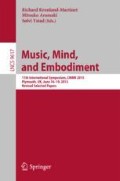Abstract
Music has the ability to cause intense emotional experiences with perceptible physical reactions as their outcome [1–3]. “Chills” or “goose bumps” have been found to be reliable indicators of emotional peaks in music listening through the combination of self-reporting methods and the concrete measurements of physical reactions [4–6]. In this way it is possible to identify musical passages that are especially effective at producing emotional peak experiences [5]. These experiences can be evoked in many ways and are often connected to music on a highly subjective level [7]. Nevertheless, large groups of listeners often seem to agree on the effectiveness of certain music and even specific passages in this regard [5, 6, 8].
References
Goldstein, A.: Thrills in response to music and other stimuli. Physiol. Psychol. 18, 126–129 (1980)
Panksepp, J.: The emotional sources of “chills” induced by music. Music Percept. 13(2), 171–207 (1995)
Gabrielson, A.: Strong experiences with music. In: Juslin, P.N., Sloboda, J.A. (eds.) Handbook of Music and Emotion: Theory, Research and Applications, pp. 547–574. Oxford University Press, Oxford (2010)
Rickard, N.S.: Intense emotional responses to music: a test of the psychological arousal hypothesis. Psychol. Music 32, 371–388 (2004)
Guhn, M., Hamm, A., Zentner, M.: Physiological and musico-acoustic correlates of the chill response. Music Percept. 24, 473–483 (2007)
Grewe, O., Kopiez, R., Altenmüller, E.: Chills as an indicator of individual emotional peaks. Ann. N.Y. Acad. Sci. 1169, 351–354 (2009)
Juslin, P.N., Liljeström, S., Västfjäll, D., Lundqvist, L.-O.: How does music evoke emotions? exploring the underlying mechanisms. In: Juslin, P.N., Sloboda, J.A. (eds.) Handbook of Music and Emotion: Theory, Research and Applications, pp. 605–642. Oxford University Press, Oxford (2010)
Sloboda, J.A.: Musical structure and emotional response: some empirical findings. Psychol. Music 19, 110–120 (1991)
Salimpoor, V.N., Benovoy, M., Larcher, K., Dagher, A., Zatorre, R.J.: Anatomically distinct dopamine release during anticipation and experience of peak emotion to music. Nat. Neurosci. 14, 257–262 (2011)
Cooke, D.: The Language of Music. Oxford University Press, Oxford (1959)
Kivy, P.: The Corded Shell: Reflections on Musical Expression. Princeton University Press, Princeton (1980)
Meyer, L.: Music and emotions: distinctions and uncertainties. In: Juslin, P.N., Sloboda, J.A. (eds.) Music and Emotion: Theory and Research, pp. 341–360. Oxford University Press, Oxford (2001)
Eitan, Z.: Highpoints: A Study of Melodic Peaks. University of Pennsylvania Press, Philadelphia (1997)
Solberg, R.T.: Waiting for the bass to drop: correlations between intense emotional experiences and production techniques in build-up and drop sections of electronic dance music. Dancecult: J. Electron. Dance Music Culture 6(1), 61–82 (2014)
Waterman, M.: Emotional responses to music: implicit and explicit effects in listeners and performers. Psychol. Music 24(1), 53–67 (1996)
Schubert, E.: Modelling perceived emotion with continuous musical features. Music Percept. 21(4), 561–568 (2004)
Grimnes, S., Martinsen, Ø.G.: Bioimpedance and Bioelectricity Basics, 2nd edn. Academic Press, Oxford (2008)
Gomez, P., Danuser, B.: Relationships between musical structure and psychophysiological measures of emotion. Emotion 7(2), 377–387 (2007)
Riener, C.R., Stefanucci, J.K., Proffitt, D.R., Clore, G.: An effect of mood on the perception of geographical slant. Cogn. Emot. 25(1), 174–182 (2011)
Wallace, W.: Sigur Rós Valtari Review. BBC Review (2012). http://www.bbc.co.uk/music/reviews/4z8r
Zatorre, R.J., Chen, J.L., Penhune, V.B.: When the brain plays music: auditory-motor interactions in music perception and production. Nat. Rev. Neurosci. 8, 547–558 (2007)
Meyer, L.B.: Emotion and Meaning in Music. The University of Chicago Press, Chicago (1956)
Shapiro, L.: Embodied Cognition. Routledge Press, New York (2011)
Thelen, E., Smith, L.B.: A Dynamic Systems Approach to the Development of Cognition and Action. The MIT Press, Cambridge (1994)
Kelso, J.A.S.: Dynamic Patterns: The Self-Organization of Brain and Behaviour. The MIT Press, Cambridge (1995)
Godøy, R.I., Leman, M.: Musical Gestures: Sound, Movement, and Meaning. Routledge Press, New York (2010)
Lakoff, G., Johnson, M.: Metaphors We Live By. The University of Chicago Press, Chicago and London (1980)
Lakoff, G., Johnson, M.: Philosophy in the Flesh: The Embodied Mind and Its Challenge to Western Thought. Basic Books, New York (1999)
Johnson, M.: The Meaning of the Body: Aesthetics of Human Understanding. The University of Chicago Press, Chicago and London (2007)
Cox, A.W.: The mimetic hypothesis and embodied musical meaning. Music Sci. 5(2), 195–212 (2001)
Acitores, A.P.: Towards a theory of proprioception as a bodily basis for consciousness in music. In: Clarke, D., Clarke, E. (eds.) Music and Consciousness: Philosophical, Psychological, and Cultural Perspectives, pp. 215–230. Oxford University Press, Oxford (2011)
Huron, D.: Sweet Anticipation: Music and the Psychology of Expectation. The MIT Press, Cambridge (2006)
Huron, D., Margulis, E.H.: Musical expectancy and thrills. In: Juslin, P.N., Sloboda, J.A. (eds.) Handbook of Music and Emotion: Theory, Research and Applications, pp. 605–642. Oxford University Press, Oxford (2010)
Walker, R.: The effects of culture, environment, age, and musical training on choices of visual metaphors for sound. Percept. Psychophys. 42(5), 491–502 (1987)
Author information
Authors and Affiliations
Corresponding author
Editor information
Editors and Affiliations
Rights and permissions
Copyright information
© 2016 Springer International Publishing Switzerland
About this paper
Cite this paper
Zeiner-Henriksen, H.T. (2016). Emotional Experiences of Ascending Melodic Lines. In: Kronland-Martinet, R., Aramaki, M., Ystad, S. (eds) Music, Mind, and Embodiment. CMMR 2015. Lecture Notes in Computer Science(), vol 9617. Springer, Cham. https://doi.org/10.1007/978-3-319-46282-0_24
Download citation
DOI: https://doi.org/10.1007/978-3-319-46282-0_24
Published:
Publisher Name: Springer, Cham
Print ISBN: 978-3-319-46281-3
Online ISBN: 978-3-319-46282-0
eBook Packages: Computer ScienceComputer Science (R0)

